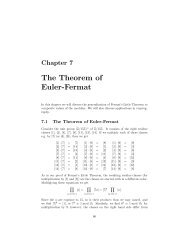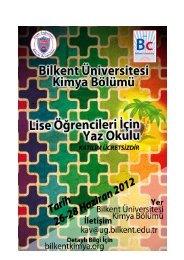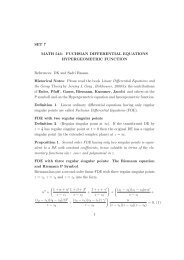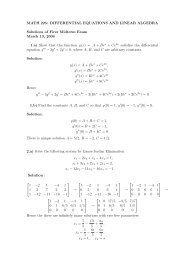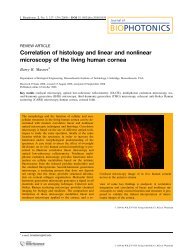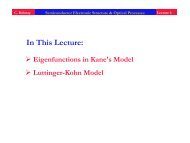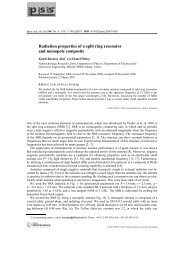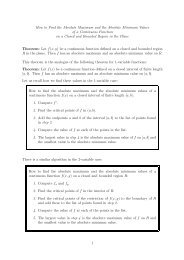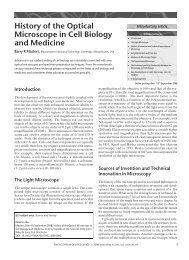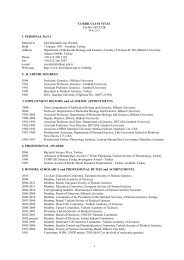Introduction to the English Edition of Hilbert's Zahlbericht
Introduction to the English Edition of Hilbert's Zahlbericht
Introduction to the English Edition of Hilbert's Zahlbericht
You also want an ePaper? Increase the reach of your titles
YUMPU automatically turns print PDFs into web optimized ePapers that Google loves.
only Hilbert’s part was actually written. It is interesting <strong>to</strong> compare Hilbert’s <strong>Zahlbericht</strong><br />
for instance <strong>to</strong> <strong>the</strong> monumental report by A. Brill and M. Noe<strong>the</strong>r “on <strong>the</strong> development<br />
<strong>of</strong> <strong>the</strong> <strong>the</strong>ory <strong>of</strong> algebraic functions in former and recent times,” 4 which is much more<br />
obviously his<strong>to</strong>rically oriented than Hilbert’s <strong>Zahlbericht</strong>, and much less <strong>of</strong> a systematic<br />
introduction <strong>to</strong> <strong>the</strong> field. On <strong>the</strong> applied side, <strong>the</strong>re was for example a report on <strong>the</strong><br />
development and <strong>the</strong> main tasks <strong>of</strong> <strong>the</strong> <strong>the</strong>ory <strong>of</strong> simple frameworks. 5<br />
Because it is above all a report, it is not in <strong>the</strong> <strong>Zahlbericht</strong> that one finds Hilbert’s<br />
most important, original contributions <strong>to</strong> number <strong>the</strong>ory—although it does include Hilbert’s<br />
pro<strong>of</strong> <strong>of</strong> <strong>the</strong> Kronecker-Weber <strong>the</strong>orem 6 as well as <strong>the</strong> <strong>the</strong>ory <strong>of</strong> higher ramification<br />
groups, i.e., Hilbert’s development from <strong>the</strong> early 1890s <strong>of</strong> Dedekind’s arithmetic <strong>the</strong>ory<br />
<strong>of</strong> Galois extensions <strong>of</strong> number fields. Indeed, Hilbert’s most impressive original contribution<br />
<strong>to</strong> number <strong>the</strong>ory came after <strong>the</strong> <strong>Zahlbericht</strong>; it was his conjectural anticipation <strong>of</strong><br />
most <strong>of</strong> <strong>the</strong> <strong>the</strong>orems <strong>of</strong> Class Field Theory, based on a remarkably deep analysis <strong>of</strong> <strong>the</strong><br />
arithmetic <strong>of</strong> quadratic extensions <strong>of</strong> number fields. This work appeared in two articles,<br />
in 1899 and 1902. The reader interested in this aspect <strong>of</strong> Hilbert’s œuvre will still have <strong>to</strong><br />
read German—see <strong>the</strong> first volume <strong>of</strong> Hilbert’s Gesammelte Abhandlungen and Hasse’s<br />
appreciation <strong>of</strong> Hilbert’s number <strong>the</strong>oretical achievements <strong>the</strong>rein. 7<br />
Coming back <strong>to</strong> <strong>the</strong> <strong>Zahlbericht</strong>, for Hilbert reporting on <strong>the</strong> state <strong>of</strong> algebraic number<br />
<strong>the</strong>ory did not mean writing an inven<strong>to</strong>ry <strong>of</strong> <strong>the</strong>orems amassed in <strong>the</strong> course <strong>of</strong> <strong>the</strong><br />
nineteenth century, 8 but ra<strong>the</strong>r <strong>the</strong> production <strong>of</strong> a conceptually coherent <strong>the</strong>ory, which<br />
would <strong>the</strong>n also point <strong>the</strong> way <strong>to</strong> fur<strong>the</strong>r research. It is because <strong>of</strong> this goal: <strong>to</strong> indicate,<br />
and <strong>the</strong>reby influence future directions <strong>of</strong> research, that Hilbert’s undertaking is most<br />
ambitious, and most open <strong>to</strong> criticism. Such criticism is <strong>of</strong> course easy <strong>to</strong> voice <strong>to</strong>day,<br />
because we can base our judgement on ano<strong>the</strong>r one hundred years <strong>of</strong> number <strong>the</strong>oretic<br />
research. Still, it is nei<strong>the</strong>r futile, nor is it a priori unjust, <strong>to</strong> put Hilbert’s text in<strong>to</strong> this<br />
perspective, because <strong>the</strong> <strong>Zahlbericht</strong> was precisely written with <strong>the</strong> idea <strong>of</strong> steering <strong>the</strong><br />
4 A. Brill, M. Noe<strong>the</strong>r, Bericht über die Entwicklung der Theorie der algebraischen Funktionen in<br />
älterer und neuerer Zeit, Jahresbericht der Deutschen Ma<strong>the</strong>matiker-Vereinigung 3 (1892–93), pp. 107–<br />
565. 5L. Henneberg, Bericht über die Entwicklung und die Hauptaufgaben der Theorie der einfachen Fachwerke,<br />
Jahresbericht der Deutschen Ma<strong>the</strong>matiker-Vereinigung 3 (1892–93), pp. 567–599.<br />
6 For a review <strong>of</strong> early (purported) pro<strong>of</strong>s <strong>of</strong> this <strong>the</strong>orem, see O. Neumann, Two pro<strong>of</strong>s <strong>of</strong> <strong>the</strong><br />
Kronecker-Weber <strong>the</strong>orem “according <strong>to</strong> Kronecker, and Weber”, J. Reine Angew. Math. 323 (1981),<br />
105–126, in particular p. 125, and N. Schappacher, On <strong>the</strong> His<strong>to</strong>ry <strong>of</strong> Hilbert’s Twelfth Problem, I: Paris<br />
1900 – Zürich 1932: The Comedy <strong>of</strong> Errors, in: Matériaux pour l’his<strong>to</strong>ire des mathématiques au XX<br />
siècle, Actes du colloque à la mémoire de Jean Dieudonné (Nice, 1996), “Séminaires et Congrès” 3<br />
(1998), 243–273.<br />
7 D. Hilbert, Gesammelte Abhandlungen, vol. 1, Berlin, Heidelberg, etc.: Springer, 1970. Hasse’s note:<br />
“Zu Hilberts algebraisch-zahlen<strong>the</strong>oretischen Arbeiten,” is on pp. 528–535.<br />
8 This may be what <strong>the</strong> D.M.V. had in mind, as <strong>the</strong>y certainly were aware <strong>of</strong> H.J.S. Smith’s report on<br />
<strong>the</strong> <strong>the</strong>ory <strong>of</strong> numbers [Collected Ma<strong>the</strong>matical Papers 1, 38–364] presented <strong>to</strong> <strong>the</strong> London Ma<strong>the</strong>matical<br />
Society, which is an invaluable document for anyone interested in <strong>the</strong> number <strong>the</strong>ory <strong>of</strong> <strong>the</strong> 19th century,<br />
but lacks <strong>the</strong> coherence <strong>of</strong> Hilbert’s <strong>Zahlbericht</strong>. — One should also mention Paul Bachmann’s work<br />
in five volumes, <strong>the</strong> fifth volume <strong>of</strong> which was already written under <strong>the</strong> influence <strong>of</strong> Hilbert’s <strong>Zahlbericht</strong>:<br />
P. Bachmann, Zahlen<strong>the</strong>orie, Versuch einer Gesammtdarstellung, Leipzig: Teubner; vol. I, Die<br />
Elemente der Zahlen<strong>the</strong>orie (1892); vol. II, Die Analytische Zahlen<strong>the</strong>orie (1894); vol. III, Die Lehre von<br />
der Kreis<strong>the</strong>ilung (1872); vol. IV, Die Arithmetik der quadratischen Formen (part 1, 1898; part 2, 1923);<br />
vol. V, Allgemeine Arithmetik der Zahlkörper (1905).<br />
2



